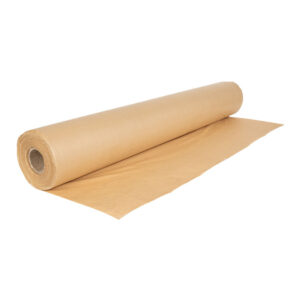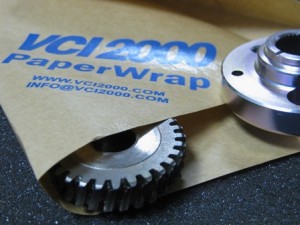In the world of industrial metals, the silent nemesis is corrosion – a relentless force that can compromise the integrity and longevity of valuable assets. As industries strive to protect their metal components, two prominent solutions have emerged: VCI (Vapor Corrosion Inhibitor) anticorrosion paper and coatings. In this comprehensive guide, we will conduct a thorough comparison of these two methods, exploring their respective pros and cons to help industries make informed decisions in their battle against corrosion.
I. Understanding VCI Anticorrosion Paper
-
Introduction to VCI Anticorrosion Paper: An Invisible Shield
VCI anticorrosion paper is a proven solution that utilizes Vapor Corrosion Inhibitors to protect metal surfaces. It forms an invisible shield around metals, preventing corrosion by creating a protective vapor phase.
-
Active Ingredients:
- Nitrites, Amines, and their derivatives are common VCI compounds.
- These compounds volatilize into the air, creating a protective layer on metal surfaces.
-
Application:
- VCI anticorrosion paper is widely used in various industries for metal storage, packaging, and transportation.
-
II. The Pros and Cons of VCI Anticorrosion Paper
A. Pros of VCI Anticorrosion Paper:
-
Ease of Application: Convenience in Packaging
-
Versatility:
- Available in sheets, rolls, or bags, making it adaptable to various packaging needs.
- Can be used as interleaving sheets or wrapping material, providing flexibility in application.
-
User-Friendly:
- Requires minimal training for application, making it accessible to a broad range of industries.
-
-
Environmental Friendliness: A Green Solution
-
Biodegradability:
- VCI anticorrosion paper is biodegradable, aligning with environmentally friendly practices.
-
Recyclability:
- The paper component is recyclable, contributing to sustainable practices.
-
-
Long-Term Storage Solutions: Extended Protection Durability
-
Inactive State:
- VCIs remain inactive until activated by moisture, ensuring prolonged protection for metals in storage.
-
Extended Durability:
- Ideal for long-term storage solutions, offering consistent protection over extended periods.
-
B. Cons of VCI Anticorrosion Paper:
-
Dependency on Activation: Effectiveness Linked to Moisture
-
Moisture Dependency:
- The effectiveness of VCI anticorrosion paper is dependent on moisture to activate the VCIs.
-
Activation Time:
- May take some time for the VCIs to activate, potentially leading to delayed protection.
-
-
Limited Thickness: Challenges with Bulky Items
-
Thickness Limitations:
- VCI anticorrosion paper may have limitations in thickness, posing challenges in protecting bulky or heavy items.
-
Adaptability:
- Some applications may require additional layers or alternative methods for effective protection.
-
III. Understanding Coatings as an Anticorrosion Solution
-
Introduction to Coatings: A Physical Barrier
Coatings, as an anticorrosion solution, involve the application of a protective layer directly onto metal surfaces. These coatings act as a physical barrier, shielding metals from the corrosive effects of the environment.
-
Types of Coatings:
- Various types of coatings exist, including paints, epoxies, and polymer coatings.
-
Application:
- Coatings are commonly used in manufacturing, construction, and marine industries for both large structures and individual components.
-
IV. The Pros and Cons of Coatings
A. Pros of Coatings:
-
Physical Barrier: Direct Protection
-
Direct Shielding:
- Coatings form a direct physical barrier, providing immediate protection to metal surfaces.
-
Uniform Coverage:
- Ensures uniform coverage over the entire metal structure or component.
-
-
Variety of Applications: Adaptable to Diverse Needs
-
Customization:
- Coatings can be customized based on the specific requirements of the metal and the environment.
-
Versatility:
- Applicable to a wide range of metals, including ferrous and non-ferrous, and diverse environmental conditions.
-
-
Thickness Control: Tailoring Protection
-
Thickness Variability:
- Coating thickness can be adjusted to suit the size and type of the metal being protected.
-
Heavy-Duty Protection:
- Suitable for heavy-duty applications where additional thickness may be necessary.
-
B. Cons of Coatings:
-
Complex Application Process: Skilled Labor Required
-
Skill Dependence:
- The application of coatings often requires skilled labor to ensure proper coverage and adhesion.
-
Specialized Equipment:
- Specialized equipment may be needed for the application, adding to the complexity.
-
-
Limited Effectiveness on Hidden Surfaces: Challenges with Complex Structures
-
Hidden Areas:
- Coatings may not effectively reach hidden or hard-to-access areas of complex structures.
-
Adhesion Challenges:
- Ensuring proper adhesion to irregular surfaces can be a challenge, impacting the overall effectiveness.
-
-
Potential for Uneven Application: Consistency Concerns
-
Application Consistency:
- Achieving uniform thickness and coverage can be challenging, leading to potential weak points in protection.
-
Maintenance:
- Regular maintenance may be required to address wear and tear, especially in high-traffic or harsh environments.
-
V. A Comparative Analysis: VCI Anticorrosion Paper vs. Coatings
A. Effectiveness in Different Environments: Tailoring Solutions
-
Harsh Environments: Coatings for Rigorous Conditions
-
Chemical Resistance:
- Coatings, especially those with chemical-resistant properties, are effective in environments with harsh chemical exposure.
-
Adverse Weather:
- Resilient against extreme weather conditions, making coatings suitable for outdoor applications.
-
-
VCI Anticorrosion Paper: Versatility in Varied Conditions
-
Versatility:
- VCI anticorrosion paper is adaptable to diverse environmental conditions, making it suitable for a broad range of applications.
-
Indoor Protection:
- Effective for protecting metals in indoor storage and transportation scenarios.
-
B. Ease of Application: Simplicity vs. Expertise
-
VCI Anticorrosion Paper: Simplicity in Usage
-
User-Friendly:
- Requires minimal training for application, making it accessible to a broad range of industries.
-
Convenience:
- Easy to handle, with various forms (sheets, rolls, bags) available for different packaging needs.
-
-
Coatings: Expertise and Precision
-
Skill Dependence:
- Coatings application often requires skilled labor for precise and uniform coverage.
-
Equipment Needs:
- Specialized equipment may be necessary for the application, adding to the complexity.
-
C. Eco-Friendliness: Green Practices in Corrosion Protection
-
VCI Anticorrosion Paper: Sustainable and Recyclable
-
Biodegradability:
- VCI anticorrosion paper is biodegradable, aligning with environmentally friendly practices.
-
Recyclability:
- The paper component is recyclable, contributing to sustainable practices.
-
-
Coatings: Environmental Impact Considerations
-
Chemical Content:
- Some coatings may contain chemicals that raise environmental concerns.
-
Waste Disposal:
- Proper disposal of waste generated during coating application is crucial to prevent environmental harm.
-
VI. Making Informed Decisions: Considerations for Industries
-
Metal Types and Industry Needs: Tailoring Solutions
-
Metal Specificity:
- Consider the types of metals being protected and their susceptibility to corrosion.
-
Industry Requirements:
- Assess specific industry needs and the environmental conditions in which the metals will be exposed.
-
-
Budget Constraints: Balancing Cost and Effectiveness
-
Cost Considerations:
- Evaluate the upfront and long-term costs associated with each method.
-
Return on Investment:
- Consider the overall effectiveness and longevity of protection in relation to the investment.
-
VII. Conclusion: A Holistic Approach to Corrosion Protection
In conclusion, the choice between VCI anticorrosion paper and coatings depends on a multitude of factors, each with its own set of pros and cons. Industries must carefully assess their unique requirements, considering the types of metals, environmental conditions, budget constraints, and the level of expertise available for application.
VCI anticorrosion paper offers a user-friendly, environmentally conscious, and versatile solution for industries looking to protect metals during storage and transportation. On the other hand, coatings provide a direct and customizable physical barrier, making them suitable for a wide range of applications, especially in harsh environments.
Ultimately, a holistic approach to corrosion protection may involve a combination of these methods, tailoring solutions based on the specific needs and challenges faced by industries. Whether through the invisible shield of VCI anticorrosion paper or the resilient armor of coatings, the battle against corrosion is one that industries can navigate successfully with informed decisions and strategic implementations.






